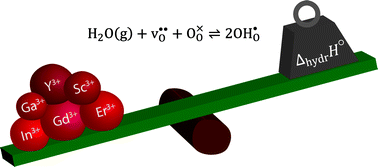The pivotal role of the dopant choice on the thermodynamics of hydration and associations in proton conducting BaCe0.9X0.1O3−δ (X = Sc, Ga, Y, In, Gd and Er)†
Abstract
The choice of acceptor has been demonstrated to result in distinctly different hydration properties in proton conducting perovskites such as BaZrO3 and BaCeO3 and may as such have significant implications for their proton conductivity. The underlying causes for these differences are, however, still not understood. The following contribution elucidates the variations in the thermodynamics of hydration and associations in acceptor doped BaCeO3 where the dopants have been chosen to encompass a wide range of ionic radii and electronegativities. This is accomplished by comprehensive thermogravimetric (TG) measurements and first principles calculations (DFT), allowing correlations of hydration properties to atomistic material properties to be drawn. The results obtained from both techniques are in excellent agreement and demonstrate that the hydration enthalpy becomes more exothermic with an increasing ionic character of the acceptor–oxygen bond. The defect structure of all studied compositions is furthermore dominated by complexes between the acceptors and oxygen vacancies or protons. The presence of such complexes will for instance inhibit the proton conductivity due to higher activation energies. The implications of acceptor-defect associates on proton concentration limits, ionic transport and hydration properties are addressed and discussed.


 Please wait while we load your content...
Please wait while we load your content...